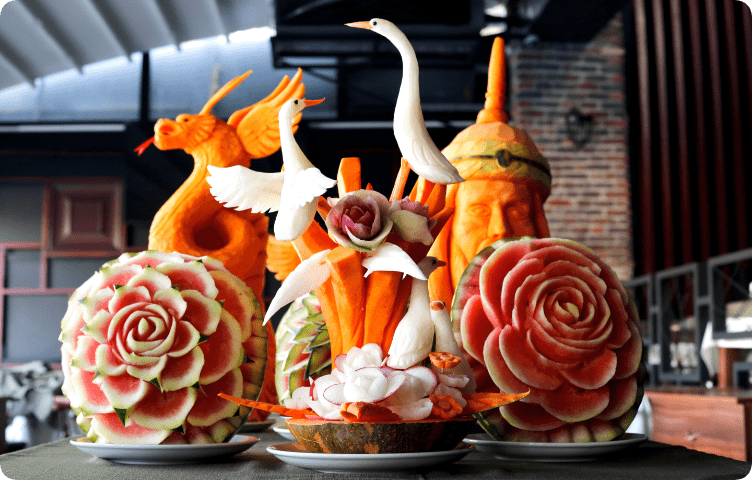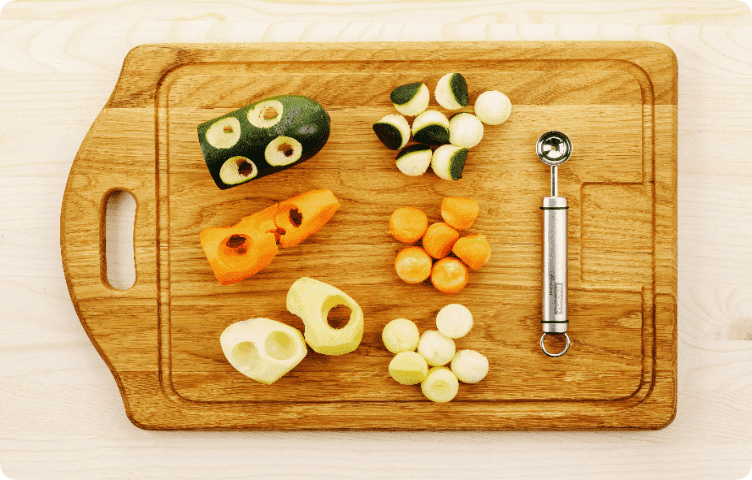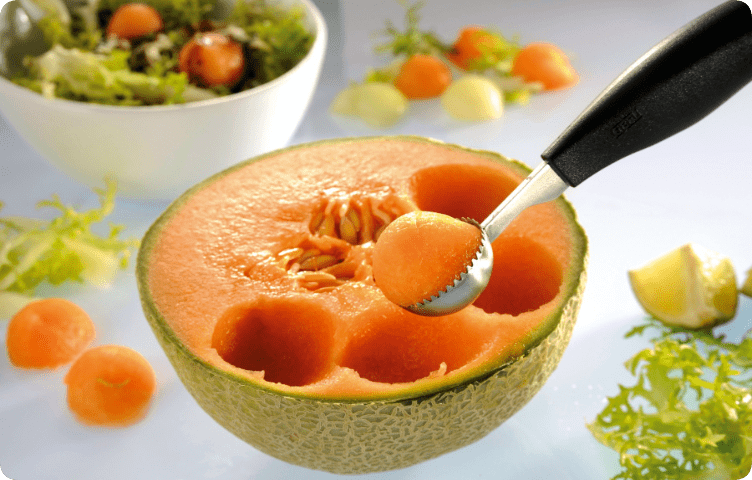Roses made from radishes and tomatoes, swans made from watermelon, funny pumpkin faces - these and other vegetable crafts perfectly decorate the table. Such beauty cannot be created with ordinary kitchen knives; special tools are required. But how to choose a good set if you have never carved before? First, get acquainted with useful information about this art!
What is carving?
The English word carving refers to an artistic technique that involves cutting beautiful shapes from vegetables and fruits. The raw materials for this work are fruits with dense pulp:
- melon;
- a pineapple;
- carrot;
- pumpkin;
- cucumber;
- radish;
- firm varieties of tomatoes.
Carving is considered a type of food design. Crafts created using this technique are used to decorate tables at banquets and weddings. Gifts in the form of baskets and bouquets carved from fruit are also popular.
The most popular motifs in carving are flowers and leaves. Salads are often decorated with figures of birds, fish, and animals. Experienced craftsmen cover the surface of vegetables with intricate patterns and carve palaces, ships and cars.

Mastering fruit carving is not as difficult as it seems. Basic skills can be practiced in one day. To improve further, two conditions are necessary - aesthetic taste and high-quality equipment.
Why do you need special tools?
In carving, special thin knives are used to create clear shapes and patterns. This kind of work cannot be done with conventional kitchen appliances. The blades must be very sharp to make precise cuts without damaging the flesh.
Carving knives have a unique shape. Depending on its purpose, the tip can be triangular, narrow, or oval. An important device is a round noisette spoon , with which balls are cut out from the pulp of watermelons and melons.
Tools for carving vegetables and fruits are made from stainless steel, which does not react with the acidic juices of fruits. The material must not leave stains on the products.

History of carving
The art of fruit carving originated 700 years ago in Sukhothai , in the north of modern Thailand. In preparation for the traditional Loy Krotang festival, a royal concubine named Nang Noppamart carved a flower and a bird from the fruit. The king and courtiers liked the girl’s skillful work so much that decorations made from vegetables and fruits became a culinary tradition in Thailand. Today this art is taught from the age of eleven in schools and continues in universities.
Japan is considered the second homeland of carving , where the technique of carving vegetables, leaves and fruits - mukimono - arose in the Middle Ages. Since the 16th century, this art has become a mandatory part of the training of Japanese chefs. Traditional decorations in the form of flowers, fans, butterflies, frogs are served on the same plate with food.
Now the art of carving is less common in Asia. But thanks to the Internet, it has spread throughout the world and is gaining popularity in Europe and Russia.
Classification of carving knives
Fruit carving tools are usually sold in sets. The basis of the set is a Thai knife, characterized by a narrow and thin blade. It is used to make deep cuts, create petals and complex patterns. There are two types of Thai knives - straight and sickle-shaped. Sometimes the cutting edge is equipped with teeth for easy cutting of fruits with delicate skin.
The set may include eight more tools:
- chisel - a product with an oval or V-shaped point that allows you to make deep grooves;
- flutter - knife for cutting into strips;
- engraving notch - a device in the form of a figured cutting edge on the handle;
- noisette - a spoon with a round scoop for cutting out balls;
- comb - a wide corrugated tool used to create shapes with a wavy surface;
- curlers - resembles a metal tube on a handle. Used for cutting out garlands;
- funnel - a cone-shaped product with blades inside. Used for making spirals or serpentine from fruit pulp;
- scissors - used for cutting thin edges.
Many sets also contain screw and peel knives, tweezers, and stencils with a cutting edge.
How to use?
The main method of work is guidance, in which deep grooves are made on the surface of the fruit. In this way you can create flower petals, bird feathers, and ornaments. Directionsperformed with a Thai knife. Another interesting technique is channeling, that is, creating shaped stripes on the fruit. For this work you will need an engraving notch.
In carving, perforation is often used - creating holes on slices of vegetables and fruits. For this task, stencils of various shapes are used, which are applied to the pulp and gently pressed.
Fruit compositions are often complemented with spirals or long stripes. These parts are made with a screw knife - inserted into the middle of the fruit and turned.
An effective way to serve watermelons and melons is in the form of balls of the same size. To cut them, the fruit is cut in half and then the balls are cut out with a rotating motion of the noisette.
Immediately after use, the devices are washed by hand using a non-aggressive detergent and wiped dry with a towel. If you purchased the set in a durable case, use it to store your tools.

Tips for choosing
The main qualities of a carving knife are the strength and sharpness of the blade. Choose products made from stainless steel, which lasts a long time and does not oxidize when in contact with acidic juices. Pay attention to the thickness of the blade - the thinner it is, the more convenient it will be to cut. A Thai knife should not only be thin, but also flexible.
Another important factor is the non-slip handle. Give preference to tools with polyamide handles, complemented by a non-slip coating.
Check what accessories are included in the kit. Beginners can get by with a Thai knife and a couple of chisels. If you are going to be serious about carving on courses, a set of 7-10 pieces would be a good choice.
Please note that the price of a quality set cannot be lower than 2000 rubles. A collection of instruments from well-known manufacturers costs from 10,000 rubles.
Sharpening blades on carving knives
Tools for carving vegetables and fruits have complex shapes, making them difficult to sharpen. But you have to do this much more often than with conventional kitchen appliances, since the blades must be impeccably sharp.
Sharpening is done with a needle file - a small file of a rectangular, triangular or round shape. Thai knives and flutters can be easily processed with a rectangular file. For chisels, combs, and noisettes, a round file is more suitable; engraving grooves are sharpened with a triangular one.
You can sharpen carving tools with a musa - a narrow ceramic rod with a handle. It is important that the length of the rod does not exceed 50 mm, otherwise it will be inconvenient to work.
When sharpening, follow three simple rules:
- position the cutting edge parallel to the surface of the file;
- sharpen the tool with smooth movements back and forth, without setting the pace too quickly;
- If the cutting edge is on one side of the knife, only cut that side.
 If you don't have sharpening skills, have a professional sharpener do the job.
If you don't have sharpening skills, have a professional sharpener do the job.















































/https%3A%2F%2Fcomplexbar.com%2Fimages%2Fblog%2F58%2Fkarving_glavn.jpg)
/https%3A%2F%2Fcomplexbar.com%2Fimages%2Fblog%2F245%2Fskov_glavn.jpeg)
/https%3A%2F%2Fcomplexbar.com%2Fimages%2Fblog%2F245%2Fhaiboli.jpg)
/https%3A%2F%2Fcomplexbar.com%2Fimages%2Fblog%2F245%2Fvilki-na-stole-752x480.jpeg)
/https%3A%2F%2Fcomplexbar.com%2Fimages%2Fblog%2F246%2F2024-04-09_17.22.54.jpg)
/https%3A%2F%2Fcomplexbar.com%2Fimages%2Fblog%2F246%2F2024-04-09_17.22.47.jpg)
/https%3A%2F%2Fcomplexbar.com%2Fimages%2Fblog%2F246%2FCODE_anons_foamydrops_752%D1%85480_eng.jpg)
/https%3A%2F%2Fcomplexbar.com%2Fimages%2Fblog%2F246%2FAlina_752%D1%85480_eng.jpg)
/https%3A%2F%2Fcomplexbar.com%2Fimages%2Fblog%2F246%2F2024-04-09_17.23.22.jpg)
/https%3A%2F%2Fcomplexbar.com%2Fimages%2Fblog%2F246%2F2024-04-09_17.23.28.jpg)
/https%3A%2F%2Fcomplexbar.com%2Fimages%2Fblog%2F246%2F2024-04-09_17.23.35.jpg)
/https%3A%2F%2Fcomplexbar.com%2Fimages%2Fblog%2F246%2Fdrinksome_752%D1%85480_eng.jpg)
/https%3A%2F%2Fcomplexbar.com%2Fimages%2Fblog%2F246%2Fnude_752%D1%85480_eng.jpg)
/https%3A%2F%2Fcomplexbar.com%2Fimages%2Fblog%2F246%2F752%D1%85480_eng__1_.jpg)
/https%3A%2F%2Fcomplexbar.com%2Fimages%2Fblog%2F246%2F752%D1%85480_eng.jpg)
/https%3A%2F%2Fcomplexbar.com%2Fimages%2Fblog%2F246%2FStudioRaw_752%D1%85480_eng.jpg)
/https%3A%2F%2Fcomplexbar.com%2Fimages%2Fblog%2F246%2FDoppio_tea_752%D1%85480_eng.jpg)
/https%3A%2F%2Fcomplexbar.com%2Fimages%2Fblog%2F246%2FTognana_Stars_Stripes_752%D1%85480_eng.jpg)
/https%3A%2F%2Fcomplexbar.com%2Fimages%2Fblog%2F246%2FRona_752%D1%85480_eng.jpg)
/https%3A%2F%2Fcomplexbar.com%2Fimages%2Fblog%2F246%2FDoppio_vending_752%D1%85480_eng.jpg)
/https%3A%2F%2Fcomplexbar.com%2Fimages%2Fblog%2F246%2FEssence_sukhie_smesi_752%D1%85480_eng.jpg)
/https%3A%2F%2Fcomplexbar.com%2Fimages%2Fblog%2F246%2FODK_sukhie_smesi752%D1%85480_eng.jpg)
/https%3A%2F%2Fcomplexbar.com%2Fimages%2Fblog%2F246%2Funiforma-barmena.jpg)
/https%3A%2F%2Fcomplexbar.com%2Fimages%2Fblog%2F246%2Fkak-nanyat-barmena.jpg)
/https%3A%2F%2Fcomplexbar.com%2Fimages%2Fblog%2F246%2Fsirop_scale_2400.jpeg)
/https%3A%2F%2Fcomplexbar.com%2Fimages%2Fblog%2F246%2FPeugeot_Anons_Paris_U%27Select_Line_Daman_752%D1%85480_eng.jpg)
/https%3A%2F%2Fcomplexbar.com%2Fimages%2Fblog%2F246%2Fkofe-vostochniy.jpg)
/https%3A%2F%2Fcomplexbar.com%2Fimages%2Fblog%2F246%2FMadler.jpg)
/https%3A%2F%2Fcomplexbar.com%2Fimages%2Fblog%2F246%2Fprofbartender_glavn.jpeg)